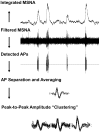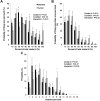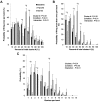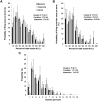Effect of varying chemoreflex stress on sympathetic neural recruitment strategies during apnea
- PMID: 31389742
- PMCID: PMC6843108
- DOI: 10.1152/jn.00319.2019
Effect of varying chemoreflex stress on sympathetic neural recruitment strategies during apnea
Abstract
We sought to examine the effect of varying chemoreflex stress on sympathetic neural recruitment strategies during end-expiratory apnea. We hypothesized that increases in the firing frequency and probability of low-threshold axons at the asphyxic "break point" would be exaggerated during hypoxia and attenuated during hyperoxia. Multiunit muscle sympathetic nervous system activity (MSNA) (peroneal nerve microneurography) was measured in 10 healthy male subjects (31 ± 2 yr, 25 ± 1 kg/m2). Individuals completed maximal voluntary end-expiratory apnea under normoxic, hypoxic (inspired O2 fraction: 0.17 ± 0.01), and hyperoxic (inspired O2 fraction: 0.92 ± 0.03) conditions. Action potential (AP) patterns were examined from the filtered raw signal with wavelet-based methodology. Multiunit MSNA was increased (P ≤ 0.05) during normoxic apnea, because of an increase in the frequency and incidence of AP spikes (243 ± 75 to 519 ± 134 APs/min, P = 0.048; 412 ± 133 to 733 ± 185 APs/100 heartbeats, P = 0.02). Multiunit MSNA increased from baseline (P < 0.01) during hypoxic apnea, which was due to an increase in the frequency and incidence of APs (192 ± 59 to 952 ± 266 APs/min, P < 0.01; 326 ± 89 to 1,212 ± 327 APs/100 heartbeats, P < 0.01). Hypoxic apnea also resulted in an increase in the probability of a particular AP cluster firing more than once per burst (P < 0.01). Hyperoxia attenuated any increase in MSNA with apnea, such that no changes in multiunit MSNA or frequency or incidence of AP spikes were observed (P > 0.05). We conclude that increases in frequency and incidence of APs during apnea are potentiated during hypoxia and suppressed when individuals are hyperoxic, highlighting the important impact of chemoreflex stress in AP discharge patterns. The results may have implications for neural control of the circulation in recreational activities and/or clinical conditions prone to apnea.NEW & NOTEWORTHY Our results demonstrate that, compared with normoxic end-expiratory apnea, hypoxic apnea increases the frequency and incidence of action potential spikes as well as the probability of multiple firing. We further show that this response is suppressed when individuals are hyperoxic. These data highlight the potentially important role of chemoreflex stress in neural firing and recruitment and may have implications for neural control of the circulation in recreational and/or clinical conditions prone to apnea.
Keywords: breath hold; carotid body; hyperoxia; hypoxia; microneurography.
Conflict of interest statement
No conflicts of interest, financial or otherwise, are declared by the authors.
Figures





Similar articles
-
Sympathetic neural recruitment strategies following acute intermittent hypoxia in humans.Am J Physiol Regul Integr Comp Physiol. 2020 May 1;318(5):R961-R971. doi: 10.1152/ajpregu.00004.2020. Epub 2020 Apr 8. Am J Physiol Regul Integr Comp Physiol. 2020. PMID: 32267729 Free PMC article.
-
Inhibition of muscle sympathetic action potential firing and recruitment patterns following cannabis inhalation in humans.J Appl Physiol (1985). 2025 Jun 1;138(6):1425-1434. doi: 10.1152/japplphysiol.00135.2025. Epub 2025 May 17. J Appl Physiol (1985). 2025. PMID: 40380816
-
Ventilation inhibits sympathetic action potential recruitment even during severe chemoreflex stress.J Neurophysiol. 2017 Nov 1;118(5):2914-2924. doi: 10.1152/jn.00381.2017. Epub 2017 Aug 23. J Neurophysiol. 2017. PMID: 28835525 Free PMC article.
-
Action potential subpopulations within human muscle sympathetic nerve activity: Discharge properties and governing mechanisms.Auton Neurosci. 2021 Jan;230:102743. doi: 10.1016/j.autneu.2020.102743. Epub 2020 Nov 6. Auton Neurosci. 2021. PMID: 33202287 Review.
-
Pathological sympathoexcitation: how is it achieved?Acta Physiol Scand. 2003 Mar;177(3):405-11. doi: 10.1046/j.1365-201X.2003.01080.x. Acta Physiol Scand. 2003. PMID: 12609013 Review.
Cited by
-
A comparison of wavelet-based action potential detection from the NeuroAmp and the Iowa Bioengineering Nerve Traffic Analysis system.J Neurophysiol. 2024 Jun 1;131(6):1168-1174. doi: 10.1152/jn.00448.2023. Epub 2024 Apr 17. J Neurophysiol. 2024. PMID: 38629146 Free PMC article.
-
Interaction of simultaneous hypoxia and baroreflex loading on control of sympathetic action potential subpopulations.J Neurophysiol. 2024 Sep 1;132(3):1087-1097. doi: 10.1152/jn.00277.2024. Epub 2024 Aug 14. J Neurophysiol. 2024. PMID: 39140588
-
The effect of hyperoxia on muscle sympathetic nerve activity: a systematic review and meta-analysis.Clin Auton Res. 2024 Apr;34(2):233-252. doi: 10.1007/s10286-024-01033-4. Epub 2024 May 6. Clin Auton Res. 2024. PMID: 38709357
-
Altered ventilatory responses to hypercapnia-hypoxia challenges in a preclinical SUDEP model involve orexin neurons.Neurobiol Dis. 2024 Sep;199:106592. doi: 10.1016/j.nbd.2024.106592. Epub 2024 Jul 4. Neurobiol Dis. 2024. PMID: 38971479 Free PMC article.
-
Sympathetic neural recruitment strategies following acute intermittent hypoxia in humans.Am J Physiol Regul Integr Comp Physiol. 2020 May 1;318(5):R961-R971. doi: 10.1152/ajpregu.00004.2020. Epub 2020 Apr 8. Am J Physiol Regul Integr Comp Physiol. 2020. PMID: 32267729 Free PMC article.
References
Publication types
MeSH terms
Substances
Grants and funding
LinkOut - more resources
Full Text Sources
Miscellaneous

